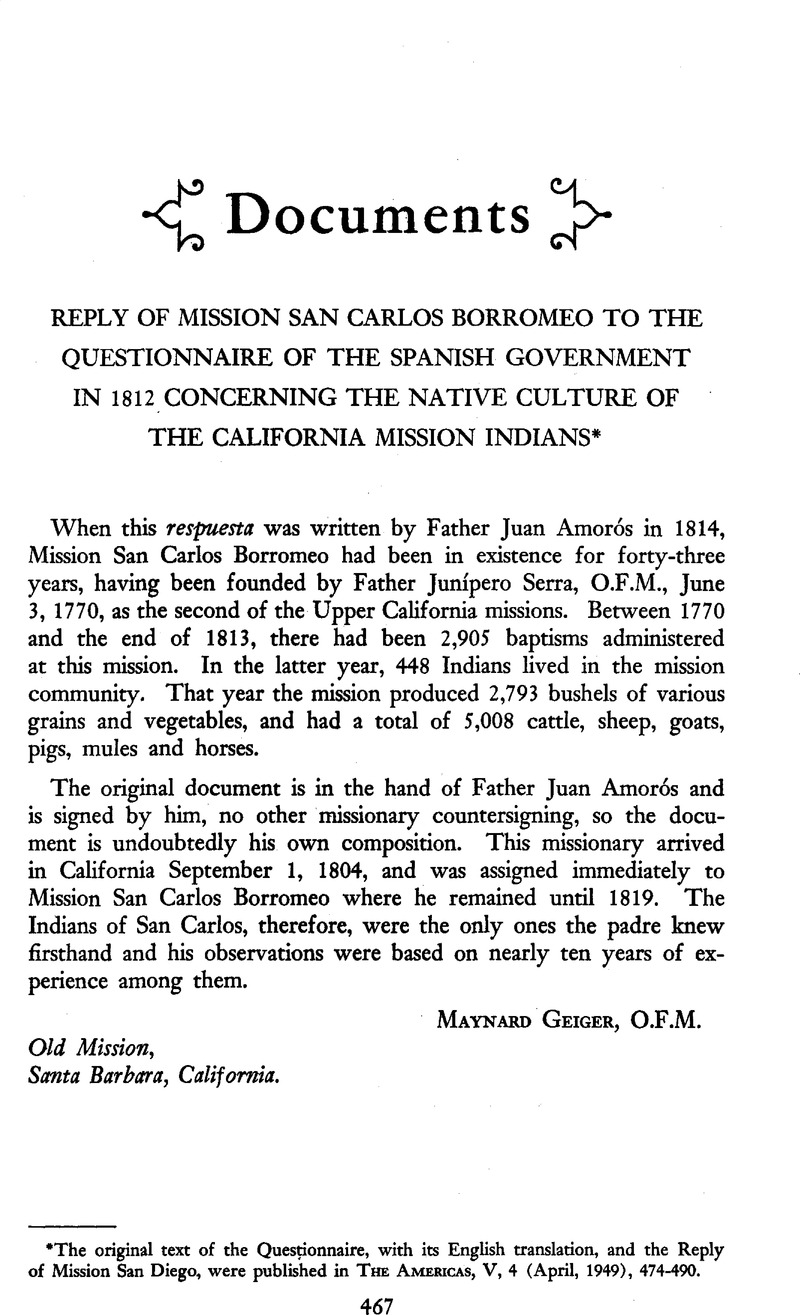Article contents
Reply of Mission San Carlos Borromeo to the Questionnaire of the Spanish Government in 1812 Concerning the Native Culture of the California Mission Indians*
Published online by Cambridge University Press: 11 December 2015
Abstract

- Type
- Documents
- Information
- Copyright
- Copyright © Academy of American Franciscan History 1950
Footnotes
The original text of the Questionnaire, with its English translation, and the Reply of Mission San Diego, were published in THE AMERICAS, V, 4 (April, 1949), 474–490.
References
1 The date may be found in the official registers of baptisms, marriages and deaths of Mission San Carlos, in the Chancery Archives, Fresno, Calif.
2 There were 36. See THE AMERICAS, V, 4 (Apr., 1949), 475–478. Father Amorós combined 1 and 2 in his first answer.
3 Mission San Carlos was founded at the present site of the town of Monterey. Father Serra personally selected a new site along the banks of the Carmel River shortly before going to establish Mission San Antonio in July, 1771. Land was cleared and preparations made during his absence. The cross was planted at Carmel at the second site of Mission San Carlos, August 24, 1771. The first chapel and missionaries’ residence there were ready for occupation by Christmas Eve, of the same year. There is only one Mission San Carlos, first located at Monterey from June 3, 1770, until December 24, 1771. The site of Mission San Carlos after that until the present day, has been at Carmel. After the mission site was changed to Carmel, Monterey was the Spanish town with its soldiers and white settlers and presidio-church. The church, built before 1800 for the military and their families, is still used as the parish church. In spiritual matters the inhabitants of Monterey were attended by the missionaries residing at Carmel. Visitors to Monterey frequently confuse the military chapel with the mission. Cf. “Informe de San Carlos,” July 1, 1784, by Junípero Serra in the hand of Father Noriega (original in the Archivo General de la Nación, Mexico City; photographic copy in the SBMA. Doc. No. 370a).
4 The name Carmelo (Carmel today) was used by the members of the Vizcaino expedition in 1602. The name Monterey was applied at the same time.
5 According to Kroeber, the seven tribes represented seven village-communities. The first two belonged to the Esselen linguistic group, variously called Excelen, Eslen, Ecclemach, Ecselen, Escelen and Ensen. The other five tribes or village-communities belonged to the Costanoan linguistic group which extended as far north as San Francisco. For details of the locality of the various tribes and the significance of the names, see Kroeber, , “A Mission Record of the California Indians,” in University of California Publications in American Archaeology and Ethnology (Berkeley, Calif.), VIII, No. 1, 20.Google Scholar
6 Classified as a Costanoan dialect.
7 See THE AMERICAS, V, No. 4, 488, for the same practice of the San Diego Indians.
8 No catechisms in the languages of the San Carlos Mission Indians are in the SBMA.
9 Father Amorós does not mean to say that the number of deaths each year was from 8 to 10, which would be insignificant. He wished to say that the population of the Mission, instead of increasing each year, was diminishing by about 10 each year. According to the tables supplied by Engelhardt, , Mission San Carlos Borromeo (Santa Barbara, 1934), 243, the decrease in the number of Indians living at the mission each year for five years prior to 1815, was about 20. The average number of deaths each year for the same five years was 42.Google Scholar
10 This soap-root is also described by Palóu in his Relación Histórica of the Life of Serra, 216–217. He calls it amole. It was also found in the San Francisco area. There was a sweet and a sour variety. The former was used for food, the latter, which lathered, was used for cleansing purposes.
11 Generally spelled habas and known as the horse-bean.
12 Literally, “I only took (it).” Engelhardt, op. cit., 129, translated it by “taking.”
13 Engelhardt’s translation of this respuesta of Amorós is complete and the writer has used his text as the basic translation in this present instance. However, a number of preferable readings have been substituted and a few corrections of translation made. See Engelhardt, op. cit., 120–134. Kroeber, op. cit., 20–24, has an abridged translation with important notes. He published the sections of the respuesta on the tribes and languages, chieftains, the temescales and sweating, songs, idolatry, origin and ancestors, healing and sorcery.
- 1
- Cited by


